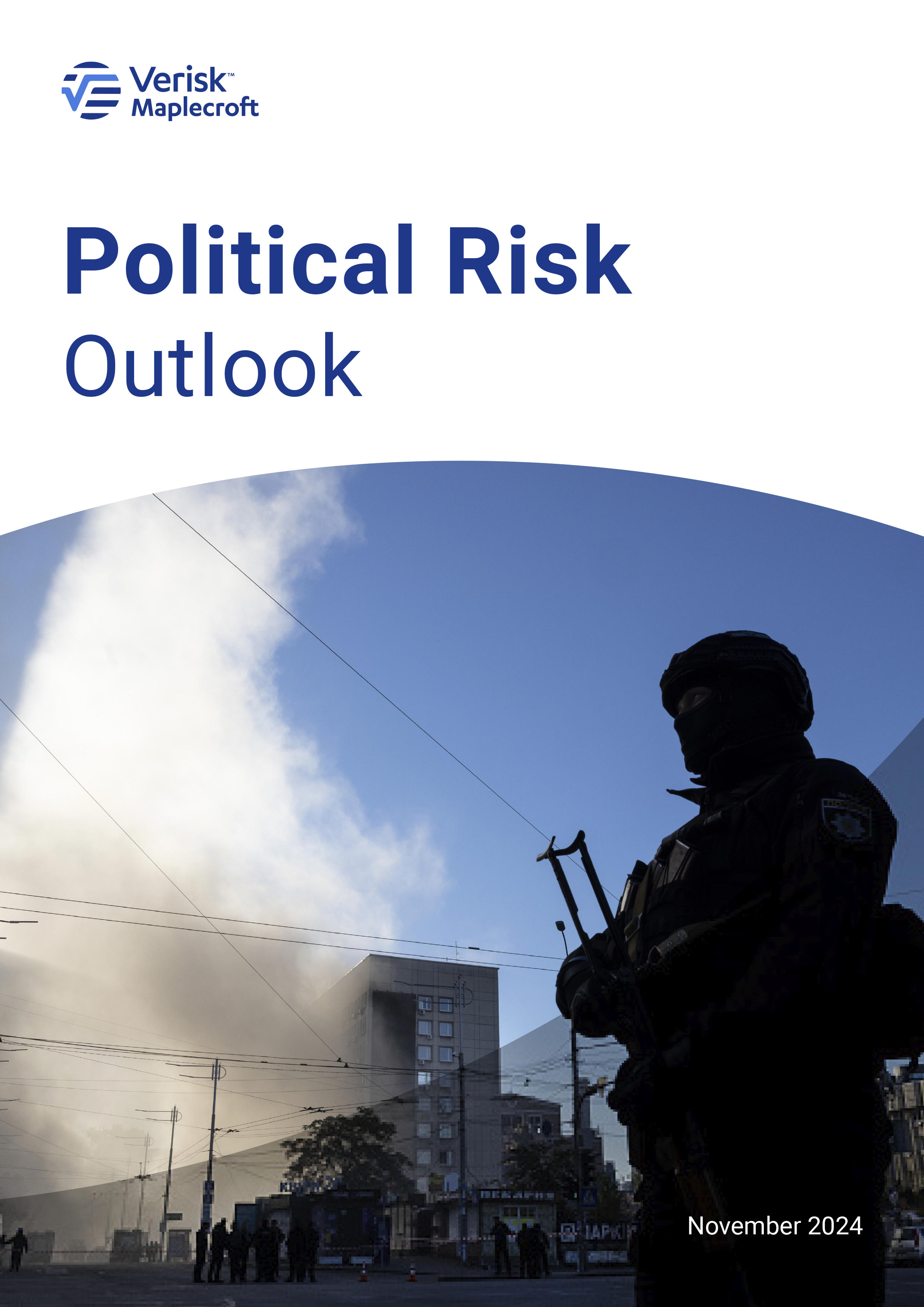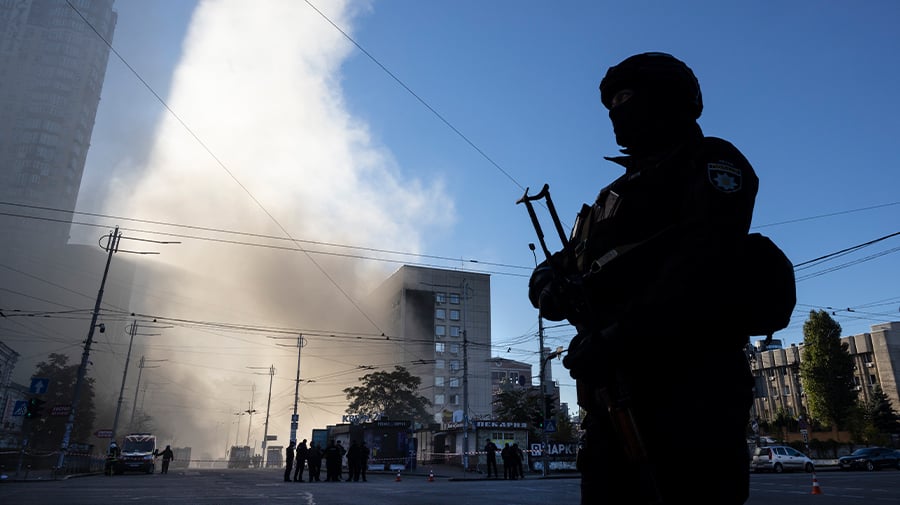Following Ukraine, the Middle East is the latest geopolitical hotspot flashing red on investors’ radar. The risks of an oil price shock and further supply chain disruptions are real, but companies that make up five of the world’s major stock markets have remained mostly insulated from the direct impacts of the conflict due to their low concentration of operations in the region. Instead, our research shows that rising tensions across several other geopolitical faultlines should be at the forefront of investors’ minds, as these have similar if not greater potential to create market shocks due to the high levels of exposure of Western stocks and strategic industries.
Using our Interstate Tensions Model to map geopolitical risk against the global footprints of 1000s of public companies, we’ve found that Europe’s largest stock market indices, the FTSE 100 (UK), CAC 40 (France) and DAX (Germany), have greater overall geographic exposure to these risks than their US and Japanese counterparts. Between half and three quarters of the assets in these European stock markets are located abroad, and around half of those are exposed to ‘very high’ geopolitical risk according to our model.
However, companies in key industries in the S&P 500 (US) and the Nikkei 225 (Japan), including strategic and highly valued technology and AI-related stocks, also have operations straddling countries on both sides of diplomatic conflicts, leaving them markedly exposed to volatility in the event of a geopolitical shock.
The key disputes measured by our Interstate Tensions Model span Asia, the US and Europe and constitute the main drivers of geopolitical risk across the stock markets we assessed. Notably, all but one of these potential flashpoints have intensified or remained elevated over the last five years. The lesson for investors and companies looking to manage their exposure to geopolitical risk is clear: the threats are systemic in nature and getting worse.
European stocks have highest exposure to geopolitics outside their borders
Geopolitical tensions affecting the stocks of companies in the home countries of these indices – the US, Japan, Germany, France and the UK – have also increased in recent years. These risks are broadly understood and priced in by most investors and issuers. But without data on the asset locations of companies globally, it is the complex and often opaque cross-border vulnerabilities of foreign assets that can create blind spots in portfolios.
Our Asset Risk Exposure Analytics (AREA), which combines the global asset locations of 50k public companies with data assessing 85 political, environmental, climate and human rights risks, has been developed to bridge this gap. According to AREA, the three European indices have higher overall foreign exposure to geopolitical risk compared to the S&P 500 and the Nikkei 225.
Most strikingly, 76% of the assets of companies in Germany’s flagship DAX index are located abroad, with 9% located in India alone. And, as shown in Figure 1, it’s a similar story for France and the UK, with 60% of the CAC 40 assets and 56% of the FTSE 100 assets located outside their listed home countries.
These extended foreign footprints translate into higher exposure to geopolitical risks. The DAX is by far the most threatened, with 35% of assets at ‘very high’ risk on our Interstate Tensions Model, which measures the risk of states engaging in disputes that include the threat, display or use of force. These hidden vulnerabilities have the potential to lead to tangible market impacts through operational disruptions, impeded trade flows, reputational risks, or sanctions and fines should they result in disputes or conflicts. The market turmoil of 2022 is a powerful example of this, when European stock markets fell by up to 17% in response to Russia’s invasion of Ukraine.
Troublingly for asset owners and asset managers, these leading market indices aren’t exposed to dozens of different conflicts that can be easily avoided or diversified away. Instead, they are all systemically vulnerable to the same set of key risk hotspots: tensions between China, the US and its Asian allies, between India and China, between India and Pakistan, and between Russia and the West, as shown in Figure 2.
Over the last five years these disputes have either remained fraught or have worsened: only in the case of India versus Pakistan have tensions marginally eased. When it comes to financial risks in the event of a major geopolitical shock, exposures on both sides of a dispute matter: a US-listed company, for example, doesn’t need to have sites in Russia to be exposed to potentially material impacts - it is enough to have key operations in sensitive European locations such as Estonia, Norway or Poland.
Strategic US, Japanese industries stretched across geopolitical divides
At the surface level, the S&P 500 and Nikkei 225 look to be on much safer ground. As Figure 1 shows, they have significantly fewer assets outside their home countries, and much lower proportions of their asset footprint exposed to ‘very high’ geopolitical risk on our Interstate Tensions Model.
However, both indices are acutely exposed in another crucial way – through the operational footprints of their key industries. As Figure 4 illustrates, many companies in the technology, electronics and AI-adjacent industries, such as semiconductors, are among the most exposed to geopolitical risks, particularly in the event of a direct confrontation of some kind in Asia. For the S&P 500 these risks are potentially very material given the extremely high valuations currently associated with these industries.
Alongside these strategic industries, apparel and retail value chains, long characterised by growth-seeking in new markets and cost-optimising offshoring, are also at risk. The supply chain exposure of all these industries, while not directly quantified here, is likely to be as great or even greater.
Trouble around the corner?
While all eyes may currently be on conflicts in the Middle East and Eastern Europe, our research suggests that investors and corporations need to maintain vigilance with regard to a range of other diplomatic disputes that could be much more consequential for company operations. As asset owners, managers and businesses deploy ever-more-sophisticated metrics to quantify and act on their exposure to climate, nature and social risks, the merits of bringing a similarly quantitative approach to political risk – especially complex cross-border geopolitical risks – have never been clearer.






